Horsetails
In the Late Carboniferous there were herbaceous as well as tree horsetails.
The trees could reach a height of up to 20 m. They provided also an important
contribution to the forming of coal.
Horsetails are characterized by articulated trunks and branches with diaphragms
(nodes). The side branches, the leaves and the spore cones are always situated
on the nodes and the leaves are attached in whorls.
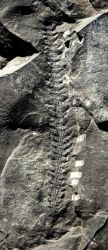
Palaeostachya or Calamostachys |
Spore cones of horsetail trees
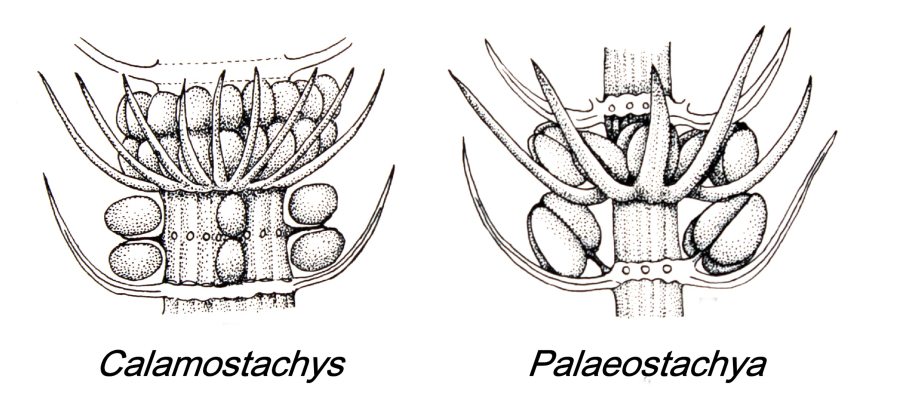
Palaeostachya and Calamostachys are spore cones of horsetail
trees. They can be distinguished from the cones of clubmoss trees because
the sterile and fertile scales are attached in whorls. It is often impossible
to separate the two genera in compressed fossils, like those of Ibbenbüren.
The difference can only be seen in case of very good preservation. In
Palaeostachya the stalked sporangia are found in the axils of the
scales, in Calamostachys they are attached in the middle of the internode.
After Stewart & Rothwell (1993). |
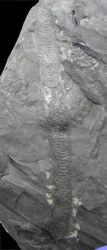
Palaeostachya or Calamostachys |

Roots of Horsetail trees
Horsetail trees had rhizomes. These are underground stems with nodes
from which rootlets sprang. These rootlets were not articulated. From time
to time a new offshoot grew from such a node, from which a new tree originated.
In this way forests of Calamites trees came into existence in which
only few other plants and trees could survive. After Taylor et
al. (2009). |
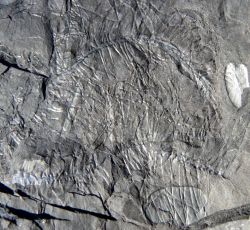
Two species of root fossils are distinguished:
Pinnularia capillacea (photo above) has roots of which the lateral rootlets
are arranged in two rows.
In Myriophyllites gracilis the lateral rootlets are irregularly
attached. |
Sphenophyllum
This is a genus of herbaceous horsetails with at the nodes whorls of
wedge-shaped leaflets which can be laciniate or not. Usually the whorls lie
as circles or ovals on the splitting surface of the rock. The nodes are somewhat
thickenened and the stems are threelateral or sixlateral. The number of leaflets
in a whorl is mostly 6, 9 or 12. Some species have several different leaf
shapes at the same plant (heterophylous plants).
Sphenophyllum has often hairy stems and leaflets ending in hooky
structures. Though individual stems can reach a great length, their diameter
is always relatively small and almost constant. Therefore it is assumed that
these stems could not stand upright independenly and that Sphenophyllum
was a climbing plant or a plant forming a dense bushy vegetation such
as nowadays our blackberry. |
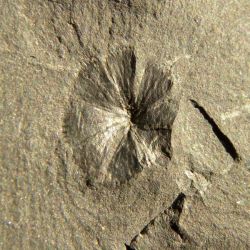 Sphenophyllum
cuneifol ium has whorls with triangular leaflets with sharp teeth
at the outside. The plant is heterophylous and has deeply incised leaflets
at the thicker axes. The species is very common. Sphenophyllum
cuneifol ium has whorls with triangular leaflets with sharp teeth
at the outside. The plant is heterophylous and has deeply incised leaflets
at the thicker axes. The species is very common. |
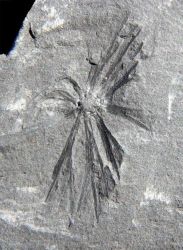 Sphenophyllum
myriophyllum is a rather rare species with very narrow leaflets which
are forked just above the attachment point. Sphenophyllum
myriophyllum is a rather rare species with very narrow leaflets which
are forked just above the attachment point. |
Top
|